Influence of Neuromuscular Activity and Technical Determinants on Scull Rowing Performance
Abstract
1. Introduction
2. Materials and Methods
2.1. Participants
2.2. Test Procedure
2.3. Data Collection
2.4. Data Analysis
2.5. Statistics
3. Results
3.1. Rowing Kinematics
3.2. Rowing Neuromuscular Activations
3.3. Effect of Technical Determinants on Performance
3.4. Effect of Neuromuscular Activations on Performance
4. Discussion
5. Limitations
6. Conclusions
Author Contributions
Funding
Institutional Review Board Statement
Informed Consent Statement
Data Availability Statement
Acknowledgments
Conflicts of Interest
Appendix A
| Base Variable | Description | Name Used |
|---|---|---|
| Wrist flexion angle | Value at catch (°) | WriCatch |
| Value at finish (°) | WriFinish | |
| Range of motion over the cycle (°) | WriRoM | |
| Elbow flexion angle | Value at catch (°) | ElbCatch |
| Value at finish (°) | ElbFinish | |
| Range of motion over the cycle (°) | ElbRoM | |
| Shoulder flexion angle | Value at catch (°) | ShoCatch |
| Value at finish (°) | ShoFinish | |
| Range of motion over the cycle (°) | ShoRoM | |
| Angle WRT vertical: thoracic spine (T6 level) | Value at catch (°) | T6Catch |
| Value at finish (°) | T6Finish | |
| Range of motion over the cycle (°) | T6RoM | |
| Angle WRT vertical: lumbar spine (L2 level) | Value at catch (°) | L2Catch |
| Value at finish (°) | L2Finish | |
| Range of motion over the cycle (°) | L2RoM | |
| Angle WRT vertical: pelvis | Value at catch (°) | PelvCatch |
| Value at finish (°) | PelvFinish | |
| Range of motion over the cycle (°) | PelvRoM | |
| Stroke angle length | Maximum oar angle–minimum oar angle (°) | Length |
| Asymmetry computed as the difference between right and left Length (°) | LengthAs | |
| Catch slip angle | Computed as the difference between the minimum oar angle at catch and the angle at which the force applied exceeds 20 kg (°) | CSA |
| Asymmetry computed as the difference between right and left CSA (°) | CSAAs | |
| Finish slip angle | Computed as the difference between the maximum oar angle at finish and the angle at which the force decreases below 15 kg (°) | FSA |
| Asymmetry computed as the difference between right and left FSA (°) | FSAAs | |
| Stroke effective angle | Length–(CSA + FSA) | EFA |
| Asymmetry computed as the difference between right and left effective angle (°) | EFAAs | |
| Negative peak of boat acceleration | Most negative value of the boat acceleration signal, after catch in Figure A1 (m/s2) | mAcc |
| Total oar force curve (starboard + board) | Time from the catch to the curve peak, expressed as percentage of the drive phase (%) | ForceT2P |
| Mean-to-peak, ratio average force in the drive phase over maximum value | ForceM2P | |
| Angle at which the peak force occurs (°) | ForceAP | |
| Muscle activations | RMS of the normalized EMG signals in each of the 8 zones of the drive and recovery phases |
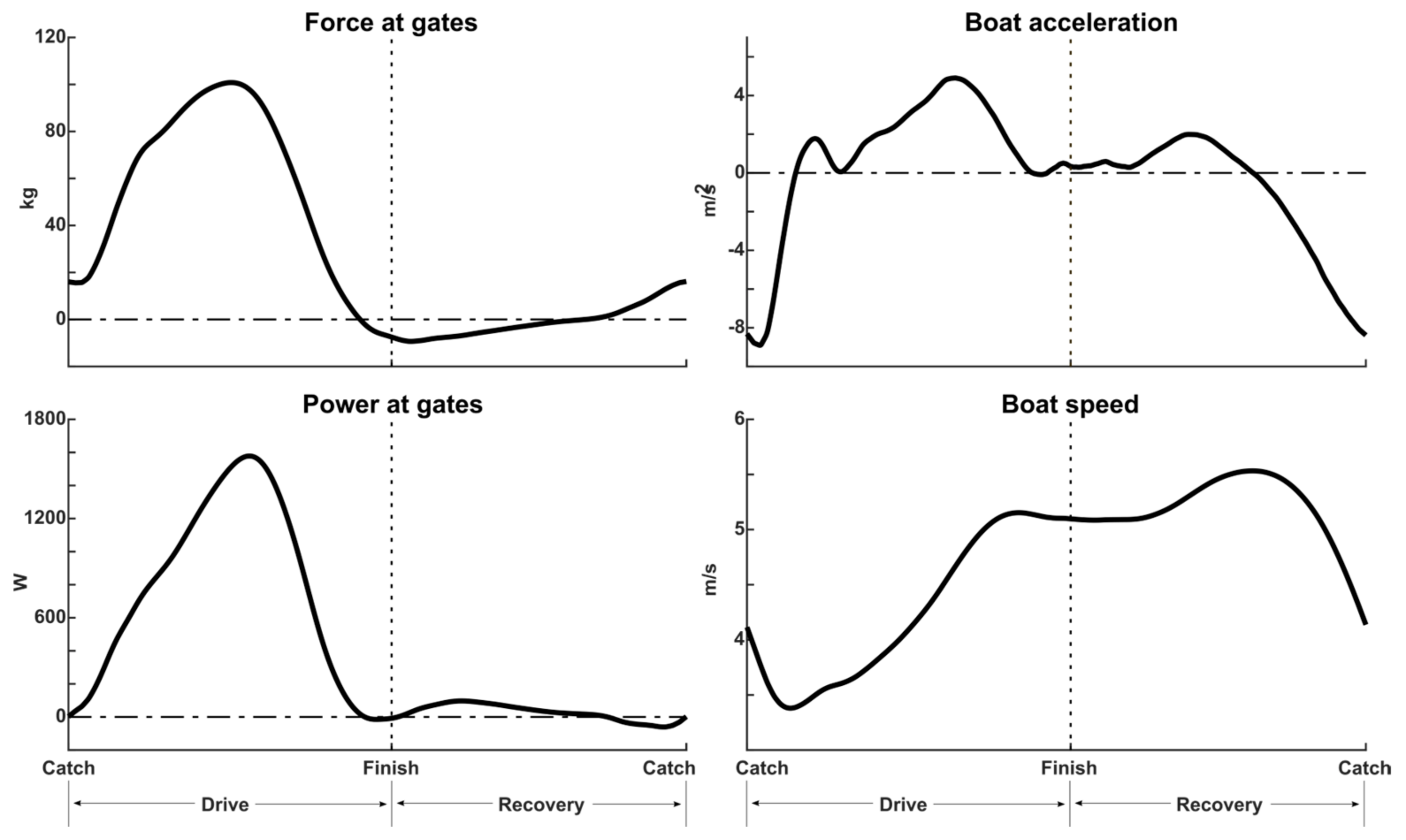
References
- Dawson, R.G.; Lockwood, R.J.; Wilson, J.D.; Freeman, G. The Rowing Cycle: Sources of Variance and Invariance in Ergometer and on-the-Water Performance. J. Mot. Behav. 1998, 30, 33–43. [Google Scholar] [CrossRef] [PubMed]
- Holt, A.C.; Aughey, R.J.; Ball, K.; Hopkins, W.G.; Siegel, R. Technical Determinants of On-Water Rowing Performance. Front. Sports Act. Living 2020, 2, 589013. [Google Scholar] [CrossRef] [PubMed]
- Valery, K. The Biomechanics of Rowing, 2nd ed.; Crowood Press: Marlborough, UK, 2016. [Google Scholar]
- Duchene, Y.; Simon, F.R.; Ertel, G.N.; Maciejewski, H.; Gauchard, G.C.; Mornieux, G. The Stroke Rate Influences Performance, Technique and Core Stability during Rowing Ergometer. Sports Biomech. 2024. [Google Scholar] [CrossRef]
- Gorman, A.J.; Willmott, A.P.; Mullineaux, D.R. The Effects of Concurrent Biomechanical Biofeedback on Novel Skill Acquisition. Sports Biomech. 2022, 21, 297–311. [Google Scholar] [CrossRef]
- Simon, F.R.; Ertel, G.N.; Duchene, Y.; Maciejewski, H.; Gauchard, G.C.; Mornieux, G. Prediction of Rowing Ergometer Performance by Technical and Core Stability Parameters. J. Sports Sci. 2023, 41, 399–407. [Google Scholar] [CrossRef] [PubMed]
- Warmenhoven, J.; Cobley, S.; Draper, C.; Smith, R. Over 50 Years of Researching Force Profiles in Rowing: What Do We Know? Sports Med. 2018, 48, 2703–2714. [Google Scholar] [CrossRef]
- Hofmijster, M.J.; Lintmeijer, L.L.; Beek, P.J.; van Soest, A.J.K. Mechanical Power Output in Rowing Should Not Be Determined from Oar Forces and Oar Motion Alone. J. Sports Sci. 2018, 36, 2147–2153. [Google Scholar] [CrossRef]
- Warmenhoven, J.; Cobley, S.; Draper, C.; Harrison, A.; Bargary, N.; Smith, R. How Gender and Boat-Side Affect Shape Characteristics of Force–Angle Profiles in Single Sculling: Insights from Functional Data Analysis. J. Sci. Med. Sport 2018, 21, 533–537. [Google Scholar] [CrossRef]
- Warmenhoven, J.; Smith, R.; Draper, C.; Harrison, A.J.; Bargary, N.; Cobley, S. Force Coordination Strategies in On-water Single Sculling: Are Asymmetries Related to Better Rowing Performance? Scand. J. Med. Sci. Sports 2018, 28, 1379–1388. [Google Scholar] [CrossRef]
- Kleshnev, V. Power in Rowing. In Proceedings of the 18 International Symposium on Biomechanics in Sports 2000, Hong Kong, China, 25–30 June 2000; pp. 2–5. [Google Scholar]
- Smith, R.; Draper, C. Skill Variables Discriminate between the Elite and Sub-Elite in Coxless Pair-Oared Rowing. Int. Soc. Biomech. Sport. 2006, 24, 1–4. [Google Scholar]
- Lintmeijer, L.L.; Knoek Van Soest, A.J.; Robbers, F.S.; Hofmijster, M.J.; Beek, P.J. Real-Time Feedback on Mechanical Power Output: Facilitating Crew Rowers’ Compliance with Prescribed Training Intensity. Int. J. Sports Physiol. Perform. 2019, 14, 303–309. [Google Scholar] [CrossRef] [PubMed]
- Li, Y.; Koldenhoven, R.M.; Jiwan, N.C.; Zhan, J.; Liu, T. Trunk and Shoulder Kinematics of Rowing Displayed by Olympic Athletes. Sports Biomech. 2020, 22, 1095–1107. [Google Scholar] [CrossRef] [PubMed]
- Martinez-Valdes, E.; Wilson, F.; Fleming, N.; McDonnell, S.J.; Horgan, A.; Falla, D. Rowers with a Recent History of Low Back Pain Engage Different Regions of the Lumbar Erector Spinae during Rowing. J. Sci. Med. Sport 2019, 22, 1206–1212. [Google Scholar] [CrossRef] [PubMed]
- Ng, L.; Campbell, A.; Burnett, A.; O’Sullivan, P. Gender Differences in Trunk and Pelvic Kinematics during Prolonged Ergometer Rowing in Adolescents. J. Appl. Biomech. 2013, 29, 180–187. [Google Scholar] [CrossRef] [PubMed][Green Version]
- Nowicky, A.V.; Burdett, R.; Horne, S. The Impact of Ergometer Design on Hip and Trunk Muscle Activity Patterns in Elite Rowers: An Electromyographic Assessment. J. Sports Sci. Med. 2005, 4, 18–28. [Google Scholar]
- Pollock, C.L.; Jenkyn, T.R.; Jones, I.C.; Ivanova, T.D.; Garland, S.J. Electromyography and Kinematics of the Trunk during Rowing in Elite Female Rowers. Med. Sci. Sports Exerc. 2009, 41, 628–636. [Google Scholar] [CrossRef]
- Pollock, C.L.; Jones, I.C.; Jenkyn, T.R.; Ivanova, T.D.; Garland, S.J. Changes in Kinematics and Trunk Electromyography during a 2000m Race Simulation in Elite Female Rowers. Scand. J. Med. Sci. Sports 2012, 22, 478–487. [Google Scholar] [CrossRef]
- Vinther, A.; Alkjær, T.; Kanstrup, I.L.; Zerahn, B.; Ekdahl, C.; Jensen, K.; Holsgaard-Larsen, A.; Aagaard, P. Slide-Based Ergometer Rowing: Effects on Force Production and Neuromuscular Activity. Scand. J. Med. Sci. Sports 2013, 23, 635–644. [Google Scholar] [CrossRef]
- Ertel, G.N.; Mornieux, G.; Simon, F.R.; Gauchard, G.C. Characterizing the Effects of an Ergonomic Handle on Upper Limbs Kinematics and Neuromuscular Activity, Comfort, and Performance during Ergometer Rowing. Appl. Ergon. 2023, 113, 104093. [Google Scholar] [CrossRef]
- Fleming, N.; Donne, B.; Mahony, N. A Comparison of Electromyography and Stroke Kinematics during Ergometer and On-Water Rowing. J. Sports Sci. 2014, 32, 1127–1138. [Google Scholar] [CrossRef]
- Hohmuth, R.; Schwensow, D.; Malberg, H.; Schmidt, M. A Wireless Rowing Measurement System for Improving the Rowing Performance of Athletes. Sensors 2023, 23, 1060. [Google Scholar] [CrossRef] [PubMed]
- Brice, S.M.; Millett, E.L.; Philippa, B. The Validity of Using Inertial Measurement Units to Monitor the Torso and Pelvis Sagittal Plane Motion of Elite Rowers. J. Sports Sci. 2022, 40, 950–958. [Google Scholar] [CrossRef] [PubMed]
- Buckeridge, E.; Hislop, S.; Bull, A.; McGregor, A. Kinematic Asymmetries of the Lower Limbs during Ergometer Rowing. Med. Sci. Sports Exerc. 2012, 44, 2147–2153. [Google Scholar] [CrossRef] [PubMed]
- Bull, A.M.J.; McGregor, A.H. Measuring Spinal Motion in Rowers: The Use of an Electromagnetic Device. Clin. Biomech. 2000, 15, 772–776. [Google Scholar] [CrossRef]
- McGregor, A.H.; Bull, A.M.J.; Byng-Maddick, R. A Comparison of Rowing Technique at Different Stroke Rates: A Description of Sequencing, Force Production and Kinematics. Int. J. Sports Med. 2004, 25, 465–470. [Google Scholar] [CrossRef]
- Holt, A.C.; Ball, K.; Siegel, R.; Hopkins, W.G.; Aughey, R.J. Relationships between Measures of Boat Acceleration and Performance in Rowing, with and without Controlling for Stroke Rate and Power Output. PLoS ONE 2021, 16, e0249122. [Google Scholar] [CrossRef]
- Doyle, M.M.; Lyttle, A.; Elliott, B. Comparison of Force-Related Performance Indicators between Heavyweight and Lightweight Rowers. Sports Biomech. 2010, 9, 178–192. [Google Scholar] [CrossRef]
- Hermens, H.J.; Freriks, B.; Disselhorst-Klug, C.; Rau, G. Development of Recommendations for SEMG Sensors and Sensor Placement Procedures. J. Electromyogr. Kinesiol. 2000, 10, 361–374. [Google Scholar] [CrossRef]
- Song, D.; Kim, E.; Bak, H.; Shin, G. Effect of Hand Loads on Upper Extremity Muscle Activity during Pushing and Pulling Motions. Appl. Ergon. 2021, 96, 103504. [Google Scholar] [CrossRef]
- Drake, J.D.M.; Callaghan, J.P. Elimination of Electrocardiogram Contamination from Electromyogram Signals: An Evaluation of Currently Used Removal Techniques. J. Electromyogr. Kinesiol. 2006, 16, 175–187. [Google Scholar] [CrossRef]
- Bianco, N.A.; Patten, C.; Fregly, B.J. Can Measured Synergy Excitations Accurately Construct Unmeasured Muscle Excitations? J. Biomech. Eng. 2018, 140, 011011. [Google Scholar] [CrossRef] [PubMed]
- Abdoli-Eramaki, M.; Damecour, C.; Christenson, J.; Stevenson, J. The Effect of Perspiration on the SEMG Amplitude and Power Spectrum. J. Electromyogr. Kinesiol. 2012, 22, 908–913. [Google Scholar] [CrossRef] [PubMed]
- Granata, K.P.; Lee, P.E.; Franklin, T.C. Co-Contraction Recruitment and Spinal Load during Isometric Trunk Flexion and Extension. Clin. Biomech. 2005, 20, 1029–1037. [Google Scholar] [CrossRef] [PubMed]
- Cholewicki, J.; Panjabi, M.M.; Khachatryan, A. Stabilizing Function of Trunk Flexor-Extensor Muscles around a Neutral Spine Posture. Spine 1997, 22, 2207–2212. [Google Scholar] [CrossRef] [PubMed]
- Hodges, P.W.; Richardson, C.A. Contraction of the Abdominal Muscles Associated with Movement of the Lower Limb. Phys. Ther. 1997, 77, 132–142. [Google Scholar] [CrossRef]
- Gorman, A.J.; Willmott, A.P.; Mullineaux, D.R. The Effects of Concurrent Biomechanical Biofeedback on Rowing Performance at Different Stroke Rates. J. Sports Sci. 2021, 39, 2716–2726. [Google Scholar] [CrossRef]

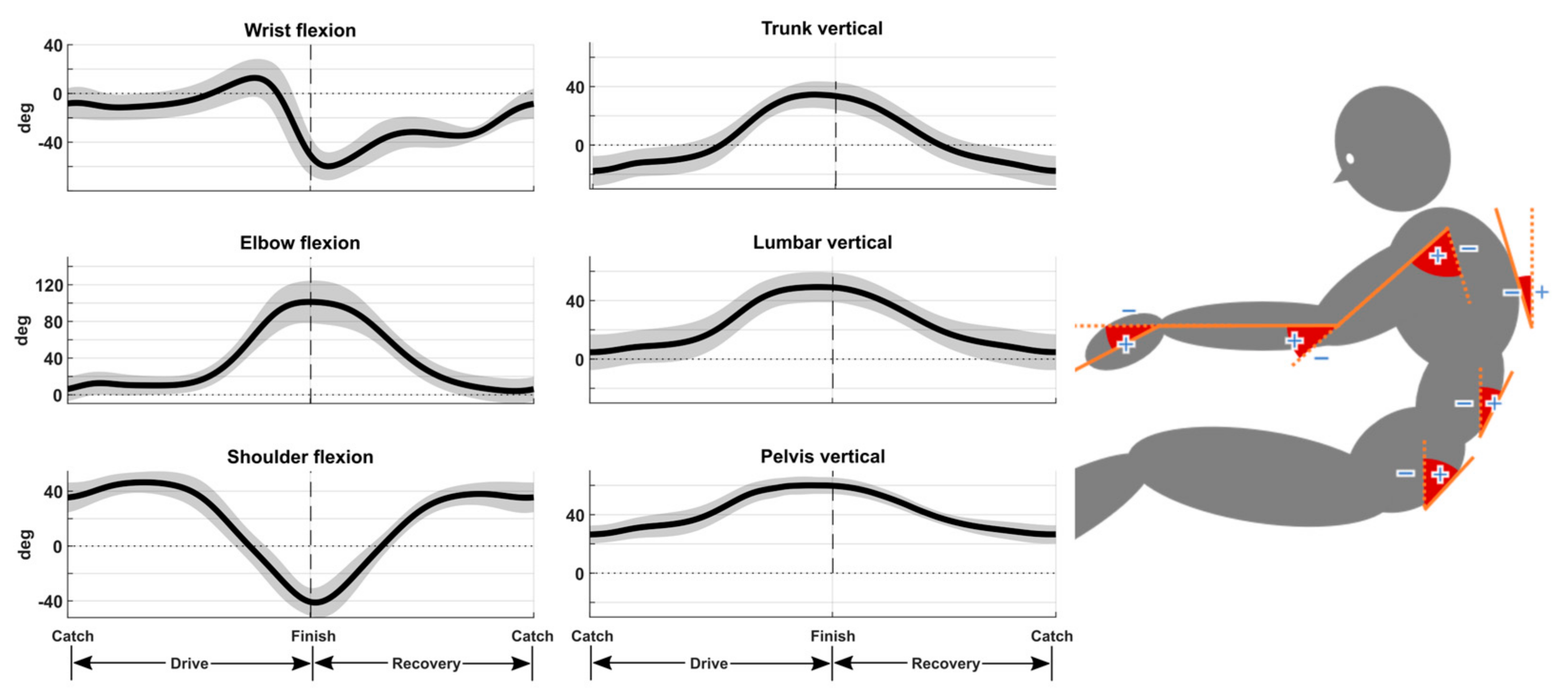
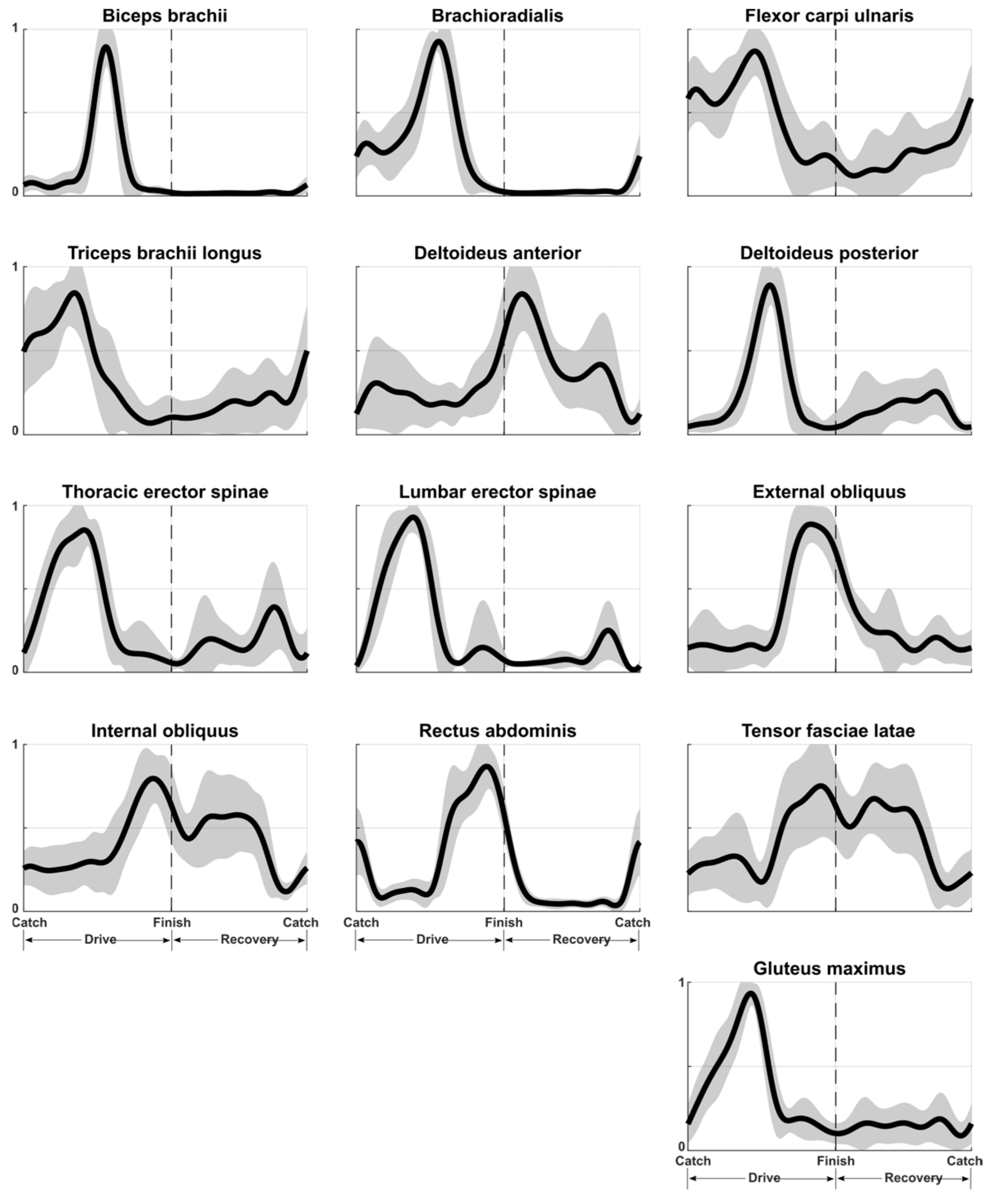
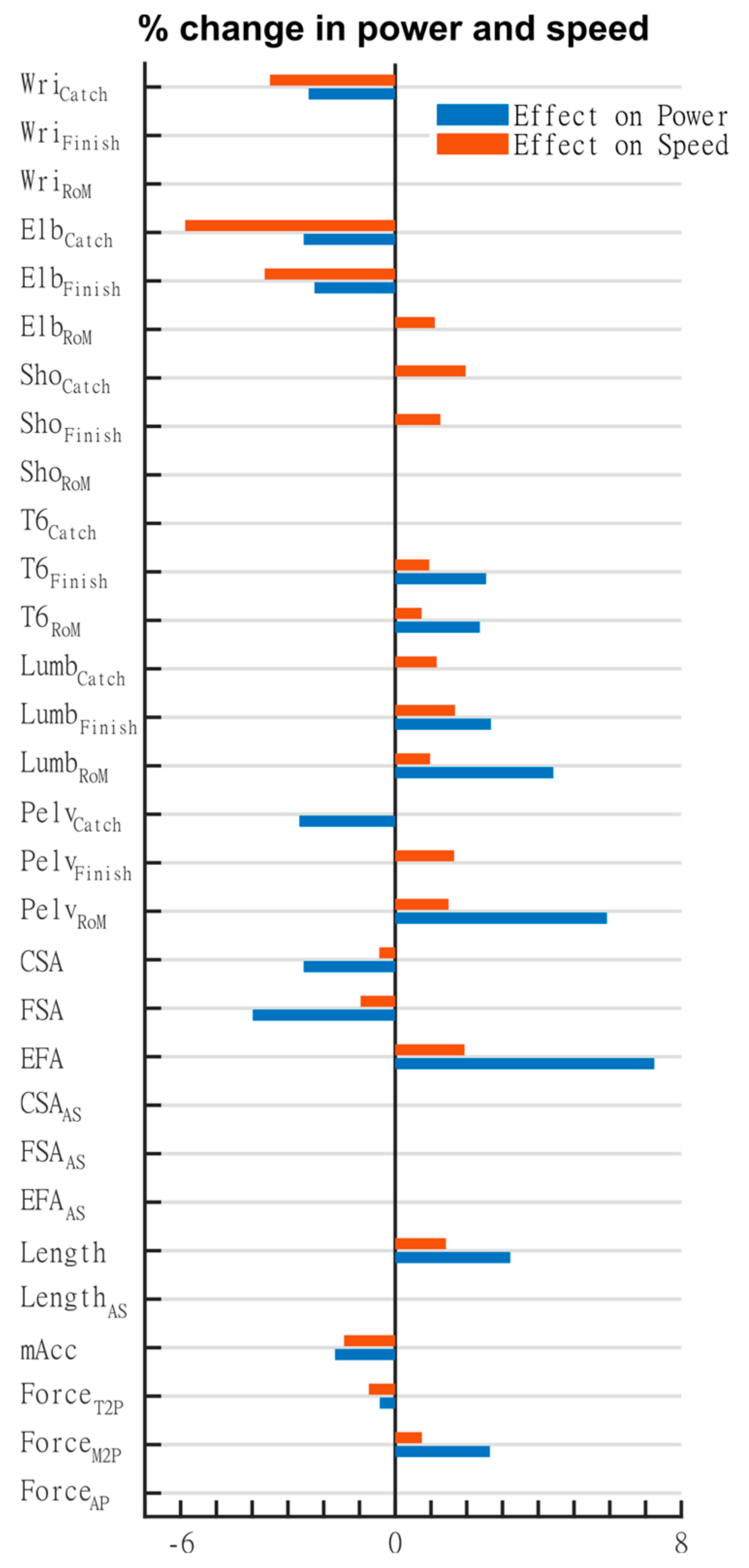
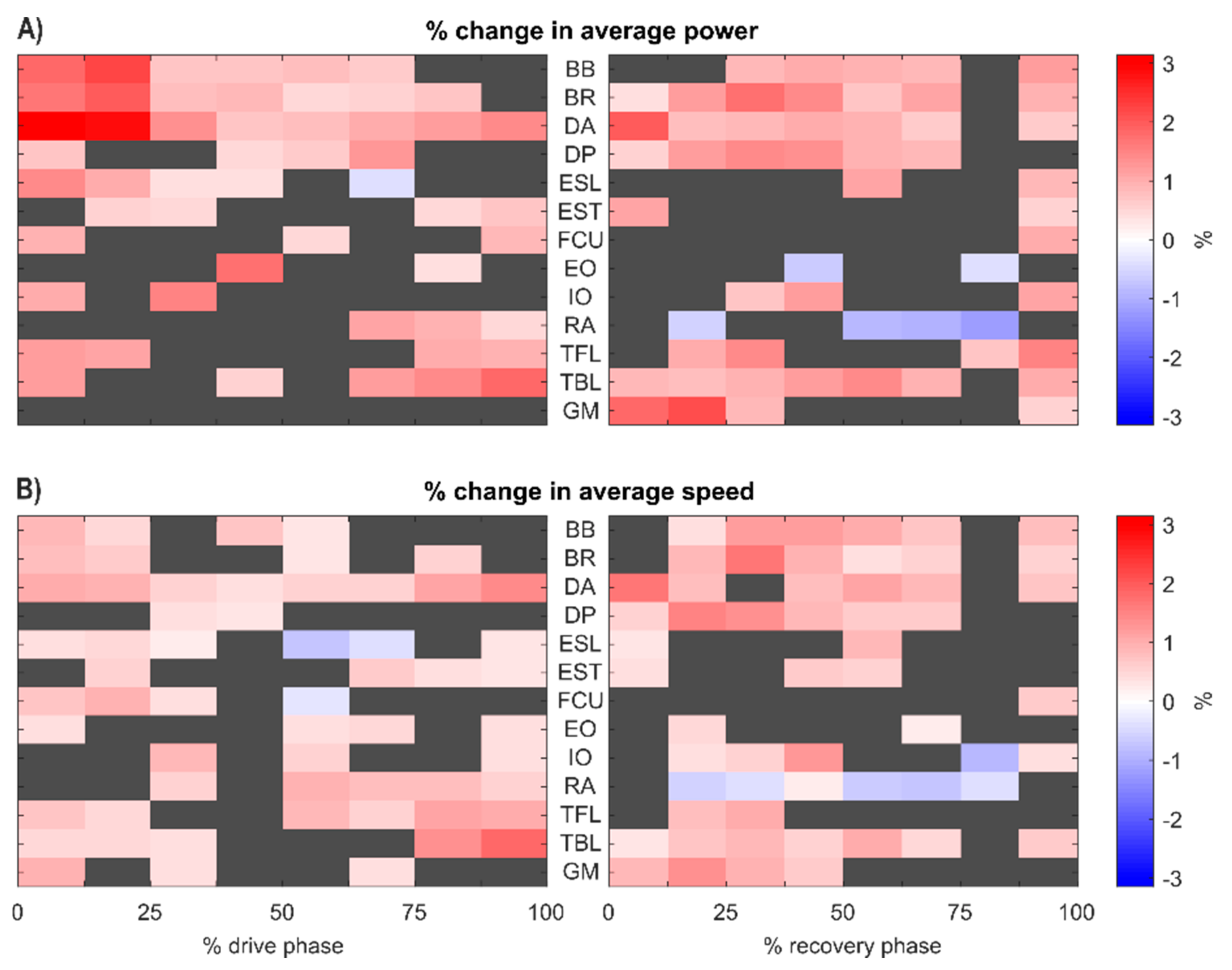

Disclaimer/Publisher’s Note: The statements, opinions and data contained in all publications are solely those of the individual author(s) and contributor(s) and not of MDPI and/or the editor(s). MDPI and/or the editor(s) disclaim responsibility for any injury to people or property resulting from any ideas, methods, instructions or products referred to in the content. |
© 2024 by the authors. Licensee MDPI, Basel, Switzerland. This article is an open access article distributed under the terms and conditions of the Creative Commons Attribution (CC BY) license (https://creativecommons.org/licenses/by/4.0/).
Share and Cite
Pitto, L.; Ertel, G.N.; Simon, F.R.; Gauchard, G.C.; Mornieux, G. Influence of Neuromuscular Activity and Technical Determinants on Scull Rowing Performance. Appl. Sci. 2024, 14, 9055. https://doi.org/10.3390/app14199055
Pitto L, Ertel GN, Simon FR, Gauchard GC, Mornieux G. Influence of Neuromuscular Activity and Technical Determinants on Scull Rowing Performance. Applied Sciences. 2024; 14(19):9055. https://doi.org/10.3390/app14199055
Chicago/Turabian StylePitto, Lorenzo, Geoffrey N. Ertel, Frédéric R. Simon, Gérome C. Gauchard, and Guillaume Mornieux. 2024. "Influence of Neuromuscular Activity and Technical Determinants on Scull Rowing Performance" Applied Sciences 14, no. 19: 9055. https://doi.org/10.3390/app14199055
APA StylePitto, L., Ertel, G. N., Simon, F. R., Gauchard, G. C., & Mornieux, G. (2024). Influence of Neuromuscular Activity and Technical Determinants on Scull Rowing Performance. Applied Sciences, 14(19), 9055. https://doi.org/10.3390/app14199055









